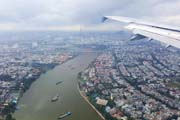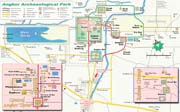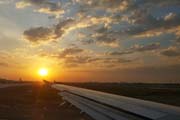The history of Angkor as we know it from inscriptions and existing temples
begins in the 9th century (shortly after 800 AD), when the young Khmer king
Jayavarman II declared himself the supreme sovereign and established his
capital Hariharalaya (near present-day Roluos). Through a program of
military campaigns, alliances, marriages and land grants, he achieved a
unification of the country bordered by China to the north, Champa (now
Central Vietnam) to the east, the ocean to the south and a place identified
by a stone inscription as "the land of cardamoms and mangoes" to the west.
In 802, Jayavarman articulated his new status by declaring himself
"universal monarch". Around the year 900, King Yasovarman I
moved the capital to Yasodharapura, that later became known as Angkor. The
first temple to be built in the new capital was the Phnom Bakheng, a
mountain temple dedicated to Shiva. Over the next 300 years, between
900 and 1200, the Khmer Empire produced some of the world's most magnificent
architectural masterpieces in the area around Angkor, which once had a
population of over one million, and was the spiritual center for the Khmers
until it was abandoned after being sacked by the Thais in 1431.
Getting there ...
 I
planned this Cambodia trip as part of our Taiwan visit during the Christmas
break. We had an early morning flight from Taiwan with a short stop in Ho Chi
Minh City, and arrived in Siem Reap, Cambodia at about 1PM. I arranged a private tour through
Happy Angkor Tour for our
5-day trip. We had a private guide, a driver, and a minivan to
take my family to explore this ancient land for the next few days.
I
planned this Cambodia trip as part of our Taiwan visit during the Christmas
break. We had an early morning flight from Taiwan with a short stop in Ho Chi
Minh City, and arrived in Siem Reap, Cambodia at about 1PM. I arranged a private tour through
Happy Angkor Tour for our
5-day trip. We had a private guide, a driver, and a minivan to
take my family to explore this ancient land for the next few days.
After
greeted by our guide Bun at the Siem Reap airport, we were taken to our
hotel for a quick break, and then started the journey to our first
stop: Kampong Phluk Floating Village on the northern
shore of Tonle Sap ("Great Lake").
Day 1 (Dec 26) ...
- Kampong Phluk Floating Village
Kampong Phluk is a cluster of three villages of stilted houses
built within the floodplain about 16 km southeast of Siem Reap. When we
got on our boat (private tour with only our family and guide), the canal was
jammed with many tour boats. All the boat drivers were fighting to
get through the narrow passage, and sometimes they had to jump across the
deck
to untangle and push the boats. During the dry season when the lake is low,
the buildings in the villages seem to soar atop their 6-meter stilts
exposed by the low water level. Visiting a floating village of
Kampong Phluk is certainly a unique experience that exposes you to the
hardships of the daily life here.
Day 2 (Dec 27) ...
- Angkor Archaeological Park
 |
Stretching over some 400 square kilometers,
including forested area, Angkor Archaeological Park contains the
magnificent remains of several capitals of the Khmer Empire of
the 9th to the 15th centuries, including the largest
pre-industrial city in the world. Angkor Archaeological
Park was declared a UNESCO World Heritage site in 1992. With
impressive monuments, several different ancient urban plans and
large water reservoirs, the site is a unique concentration of
features testifying to an exceptional civilization. Temples such
as Angkor Wat,
Bayon,
Preah Khan and
Ta Prohm, exemplars of
Khmer architecture, are closely linked to their geographical
context as well as being imbued with symbolic significance. |
- Bayon
Built in the late 12th or early 13th century
by King Jayavarman VII, the Bayon stands at the center of Jayavarman's
capital, Angkor Thom. The Bayon was the last state temple to be built
at Angkor, and the only Angkorian state temple to be built primarily as
a Mahayana Buddhist shrine dedicated to the Buddha. It was the
centerpiece of Jayavarman VII's massive program of monumental
construction and public works, which also included the walls
and nāga-bridges of Angkor Thom, and the temples of Preah Khan, Ta Prohm
and Banteay Kdei.
The Bayon's most distinctive feature is the
multitude of serene and smiling stone faces on many towers
(originally there were 49 towers, but only 37 are standing today) which jut
out from the upper terrace and cluster around its central peak.
The temple is known also for two impressive sets of bas-reliefs,
which present an unusual combination of mythological, historical, and
mundane scenes.
- Baphuon
Built in the mid-11th century, the Baphuon is a
three-tiered temple mountain built as the state temple
of Udayadityavarman II dedicated to the Hindu God Shiva. The outermost
(4th) enclosure, 425m x 125m, borders the Royal Palace to the north,
while a raised causeway 172m long (a later addition) leads from the east
entrance to the temple mountain. In the late 15th century, the
Baphuon was converted to a Buddhist temple. A 9 meter tall by 70 meter
long statue of a reclining Buddha was
built on the west side's second level.
The Baphuon Temple is one of the quieter of the main Angkor ruins,
despite being almost right next to the Bayon Temple. With large, open grounds, the temple is almost
palatial, creating a peaceful place to enjoy the open air and a clearer
view of the impressive architecture with a steep climb to the upper
tier.
- Elephant Terrace
The Terrace of the Elephants is a striking
350-metre-long and 2.5-metre-high ornamental wall which, as the name
suggests, is mostly decorated with carved elephants. It was built in the
late-12th century as a view platform, from which King Jayavarman VII
viewed his victorious returning army.
- East Gate of Angkor Thom
Angkor Thom ("Great City"), one of the
largest of all Khmer cities (3 km by 3 km), was established as the capital
of Jayavarman VII's empire, and was the center of his massive building
program. Instead of stopping at the South Gate when we entered the
Angkor Thom like most visitors did, we went to the East Gate when we
exited the Angkor Thom and there were much fewer tourists here (all five
gates are similar although the South Gate has been most extensively
restored).
- Ta Kou, Angkor Wat
After lunch at a local restaurant, we went to
Angkor Wat via its eastern entrance (Ta Kou). It was much quieter on
the eastern side of the Angkor Wat as most of visitors enter
from its main western entrance.
- Angkor Wat
Angkor Wat ("City Temple") is the most famous ancient
temple site in Cambodia, and it is also the world's largest religious
monument. King Suryavarman II built Angkor Wat in the early 12th
century, at the height of the Khmer Empire’s power. Breaking from
the Shiva tradition of previous kings, Angkor Wat was dedicated
to Vishnu and was built as the king's state temple and capital city.
Towards the end of the 12th century, Angkor Wat gradually transformed
from a Hindu center of worship to Buddhism, which continues to the
present day. Angkor Wat combines two basic plans of Khmer temple
architecture: the temple-mountain and the later galleried temple.
Unlike most Khmer temples, Angkor Wat is oriented to the west rather
than the east, which has led many to conclude that Suryavarman intended
it to serve as his funerary temple.
As the best-preserved temple at
the site, it is the only one to have remained a significant religious
center since its foundation. The temple is at the top of the high
classical style of Khmer architecture. It has become a symbol
of Cambodia, appearing on its national flag, and it is the country's
prime attraction for visitors (more than 2 million in 2012, while there
were only 7650 visitors in 1993).
- Apsara Dance
After a short break in the hotel, we went to a
dinner buffet and Apsara dance show in Siem Reap. According to the
Hindu mythology, Apsaras were beautiful female creatures that descended
from heaven to entertain Gods and Kings with their dance. The Apsara
dance is a traditional dance of the Kingdom of Cambodia that dates back
to the 7th century according to some of the carvings found at the Sambor
Prei Kuk temples (Cambodia’s Kompong Thom province) which immortalized
Apsaras dancing on the stone.
Our guide and driver went back earlier
so they helped arrange a
tuk-tuk to take us back to the hotel. It was quite an
interesting experience to take a tuk-tuk in the busy street where
traffic was so randomly flowing...
Day 3 (Dec 28) ...
- Sunrise at Angkor Wat
I met with our guide at 5AM to go to the
Angkor Wat for the sunrise. It was such a popular activity that
there were already too many tourists around the pond in front of the
temple when we got there before 5:30AM (sunrise was around 6:45AM).
However, some people left before 6:30AM since they were disappointed
that the sky was kind of dull before sunrise because of too much low
cloud. I think I was happy to stay longer till the sunrise to start a new
day :-)
- Phnom Kulen Mountain
After breakfast, we headed north to Phnom
Kulen Mountain. About 50 km from Siem Reap, Phnom Kulen is an
isolated chain of small mountain plateau of moderate height with
averaging 400 m all along the range and peak of 487 m. We visited
2 waterfalls, over 1000 small linga carvings etched into
the sandstone riverbed, and Preah Ang Thom, a 16th-century Buddhist
monastery notable for the giant reclining Buddha, the country's largest.
- Banteay Srei
A little more than 20km north of Angkor, almost at
the foot of the Kulen Mountains, sits the remarkable small temple of
Banteay Srei ("Citadel of the Women"). Consecrated on 22 April 967 A.D.,
Banteay Srei was the only major temple at Angkor not built by a monarch;
its construction was credited to the courtiers named Yajnavaraha, who
served as a counselor to king Rajendravarman II. Banteay Srei, dedicated
to Hindu god Shiva, was built largely of red sandstone, a medium
that lends itself to the elaborate decorative wall carvings which are
still observable today.
- Ta Prohm
Ta Prohm ("ancestor of Brahma"), originally called Rajavihara
("monastery of the king"), was one of the first temples founded when King
Jayavarman VII embarked on a massive program of construction and public
works. The principal divinities of Ta Prohm were installed in 1186
to transfer merit to the king's mother. Unlike most Angkorian
temples, Ta Prohm is in much the same condition in which it was found: the
photogenic and atmospheric combination of trees growing out of the ruins
and the jungle surroundings have made it one of Angkor's most popular
temples with visitors. This was an inspired decision to leave it as
an example of how most of Angkor looked on its discovery in the 19th
century, and involved a significant amount of work to prevent further
collapse. The temple of Ta Prohm was used as a location in the
film "Tomb Raider" (2001).
- Prae Roup (or Pre Rup)
Prae Roup is a Hindu temple, built as the
state temple of Khmer king Rajendravarman and dedicated in 961 or early
962. It is a temple mountain of
combined brick, laterite and sandstone construction. Climbing to
the top of the temple affords a sweeping view of the surrounding
countryside jungle and rice paddies, and it is also a popular place for
sunset viewing.
Day 4 (Dec 29) ...
- Preah Khan
One of Jayavarman VII's largest projects, Preah
Khan ("Holy Sword") was much more than a temple: with 1000 teachers it
appeared also to have been a Buddhist university as well as a
considerable city. Built in the 12th century for
King Jayavarman VII to honor his father, Preah Khan is flat in design,
with a basic plan of successive rectangular galleries around
a Buddhist sanctuary complicated by Hindu satellite temples and numerous
later additions. Like the nearby Ta Prohm, Preah Khan has been left
largely unrestored, with numerous trees and other vegetation growing
among the ruins.
- Ta Som
Ta Som, built at the end of 12th century for King
Jayavarman VII, is a small temple like a miniature simplified version of
Ta Prohm. Like the nearby Preah Khan and Ta Prohm, the temple was
left largely unrestored, with numerous trees and other vegetation
growing among the ruins.
- East Mebon
Built during the reign of King Rajendravarman in the
10th century, the East Mebon stands on what was an artificial island at
the center of the now dry East Baray reservoir. The East Mebon was
dedicated to the Hindu god Shiva and honors the parents of the king. The
temple was built on a north–south axis with Rajendravarman’s state
temple, Pre Rup, located about 1,200 meters to the south just outside
the baray. The sculpture at the East Mebon is varied and
exceptional, including two-meter-high free-standing stone elephants at
corners of the first and second tiers.
- Beng Mealea
Located 40 km east of the main group of temples at Angkor on the ancient
royal highway, Beng Mealea ("Lotus Pond") was built as a Hindu temple,
but there are some carvings depicting Buddhist motifs. The history
of the temple is unknown and it can be dated only by its architectural
style, identical to Angkor Wat, so scholars assumed it was built during
the reign of king Suryavarman II in the early 12th century.
Beng Mealea is a jungle temple with more than 1 sq. km in area, and is
mostly overgrown by vegetation. It has been left the way it was
discovered, similar to Ta Prohm Temple. With many trees growing out of
broken-down towers and galleries, and vegetation covering ruined
structures, it provides the opportunity for some great ‘lost temple’
photos.
- Angkor Wat
I asked our guide to take us back to Angkor Wat in the
late afternoon so I could take more pictures of the temple in the reflection
from its western side. I was glad I was able to get these iconic
views of Angkor Wat.
Day 5 (Dec 30) ...
- Sunrise at Phnom Bakheng
Phnom Bakheng was constructed on the
79-metre-tall Bakheng Hill, and was the first major temple to be built
at Angkor after the capital was moved from Roluos in the 9th century,
two centuries before Angkor Wat. It was the state-temple of King
Yasovarman I, at the heart of the new capital city of Yasodharapura.
Phnom Bakheng is the highest temple in the Angkor Archaeological Park,
offering the best panoramic views of the whole area.
Instead
of coming here for sunset as most of tourists do, I came in the early
morning for sunrise. We were the first to arrive at the top of the
hill when it was still dark that I could take a few pictures of
night stars. It
also has a view of Angkor
Wat which looked particularly mysterious at dawn.
- Artisans Angkor
Artisans Angkor is a semi-public company creating job opportunities for
young people while reviving traditional Khmer craftsmanship such as
stone and wood carving, painting on statues and on silk, lacquering, and
silver plating. It offers free guided tour going through its
workshops and also has a very nice gift shop with high-end
silk products and art crafts.
- Siem Reap Market & Streets
- Wat Preah Prom Rath
Though it’s more than 500 years old, Wat
Preah Prom Rath is a modern-looking temple and monastery located in the
heart of Siem Reap. The temple grounds are large, home to a university
building as well as the main hall with a sitting Buddha and a reclining Buddha. Our guide Bun was a monk pupil here before,
and he shared a lot of his Buddhism learning and principles with us in
the past few days.
Going Home ...
 |
We were dropped off at the Siem Reap airport before
noon to catch our flight back to Taiwan. Angkor Cambodia is
really a fantastic place full of history (but unfortunately being
forgotten by most of the world now). I am particularly drawn
to the story of the great king
Jayavarman
VII who lived to 93 years old and built most grand Buddha
temples such as Bayon, Ta Prohm, Preah Khan, etc. In the past
4 days we could only visit 11 temples in the area where there are
hundreds of temples to be explored. If you like history,
archaeology, indigenous culture, and photography, this is definitely
a place worth visiting. |
[Angkor Gallery]
[Back to Photo Page]
I
planned this Cambodia trip as part of our Taiwan visit during the Christmas
break. We had an early morning flight from Taiwan with a short stop in Ho Chi
Minh City, and arrived in Siem Reap, Cambodia at about 1PM. I arranged a private tour through
Happy Angkor Tour for our
5-day trip. We had a private guide, a driver, and a minivan to
take my family to explore this ancient land for the next few days.